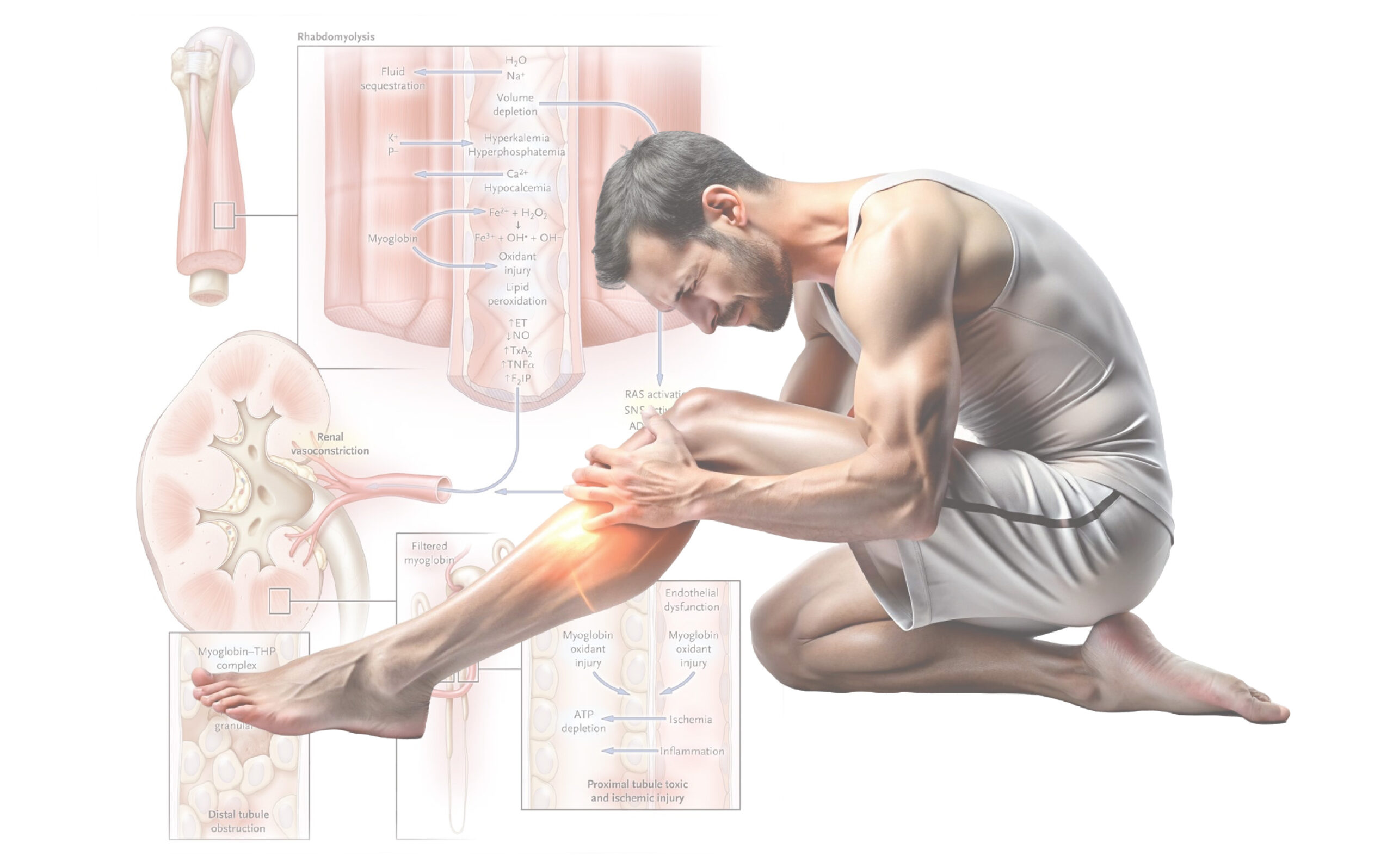What is Exertional Rhabdomyolysis?
Exertional rhabdomyolysis (ER) is the breakdown of muscle tissue due to intense physical activity, releasing harmful proteins like myoglobin into the bloodstream. This can lead to kidney damage if not properly managed.
Common Symptoms of ER:
- Muscle pain, stiffness, or swelling
- Dark-colored (tea or cola-like) urine
- Fatigue or muscle weakness
- Nausea and vomiting
Risk Factors for ER:
- High-intensity exercise: Excessive or unaccustomed physical exertion
- Dehydration: Lack of adequate hydration during strenuous activity
- High heat and humidity: Increases the risk of dehydration and muscle breakdown
- Genetics: Certain muscle enzyme deficiencies or other genetic factors
- Medications/Supplements: Certain medications (e.g., statins) or performance-enhancing supplements
Preparticipation Screening:
- Medical History & Physical Examination
– Identify any history of muscle disorders, previous episodes of rhabdomyolysis, or family history of muscle-related diseases.
– Review medications, supplements, and past exercise routines.
– Assess for underlying conditions like sickle cell trait, heat intolerance, or metabolic diseases. - Baseline Laboratory Testing – Consider testing for baseline Creatine Kinase (CK) levels, especially in athletes with previous ER episodes or muscle disease risk.
- Cardiovascular and Muscular Fitness Evaluation – Assess fitness levels and muscular endurance to design a safe, progressive exercise plan.
- Individualized Exercise Plan – Gradual increase in exercise intensity, especially for those with previous rhabdomyolysis or muscle disorders.
-Include warm-ups and cooldowns to prevent sudden strain on muscles.
Preventive Measures for ER:
- Progressive Training
– Gradually increase exercise intensity and duration to allow muscles to adapt.
– Avoid sudden, extreme changes in workout volume, especially for beginners or after long breaks. - Hydration
– Drink water consistently before, during, and after exercise.
– In hot climates, ensure electrolyte balance to prevent dehydration and muscle cramping. - Monitor Exercise Conditions
– Avoid strenuous exercise in extreme heat or humidity.
-Schedule workouts during cooler parts of the day when possible. - Rest and Recovery
– Allow sufficient time for muscle recovery between intense workouts.
– Incorporate rest days and cross-training to minimize strain on specific muscle groups. - Recognize Warning Signs
– Pay attention to muscle pain beyond typical soreness, especially if combined with dark urine, swelling, or persistent weakness.
– Stop exercise immediately and seek medical attention if ER symptoms occur.
Safe Return to Exercise After ER:
- Consult Healthcare Providers
– Work with a physician or sports medicine specialist to monitor recovery and assess muscle function through blood tests (e.g., CK levels). - Gradual Return
– Follow a tailored return-to-exercise plan with low-intensity, short-duration activities, progressively increasing based on tolerance and recovery - Ongoing Monitoring
– Regularly assess muscle recovery and energy levels.
– Maintain hydration, balanced nutrition, and avoid high-intensity exercise until full recovery is confirmed.
Key Takeaways:
- Prevention is Key: Focus on gradual, well-monitored exercise routines, proper hydration, and awareness of environmental conditions.
- Preparticipation Screening: A thorough medical and fitness evaluation helps identify risks and design safe exercise programs.
- Return to Exercise: After an episode of ER, a gradual, medically supervised return is essential for preventing recurrence.
By Dr Gurmeet Singh A/L Gurdial Singh, Consultant Sports Physician

